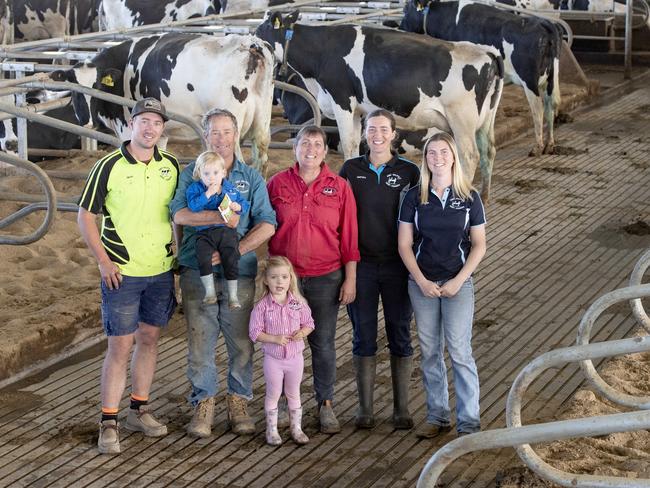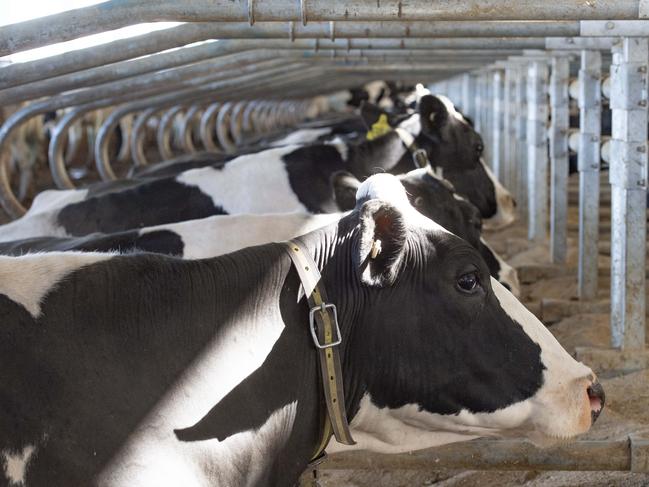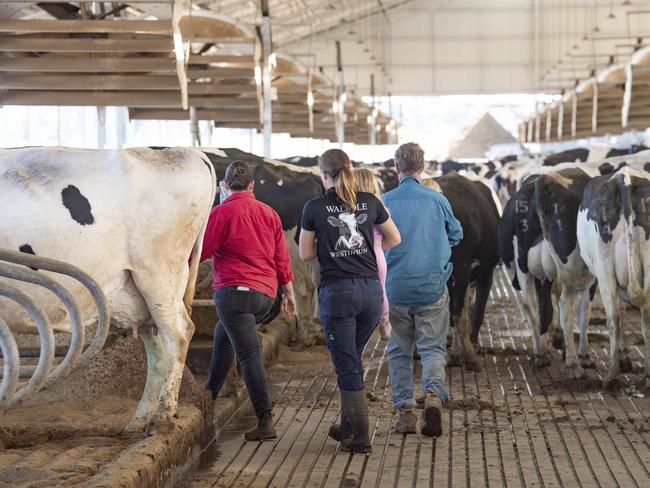Farmer of the Year 2023: Dairy farmers Mark and Kate Walpole
Kate and Mark Walpole run a dairy herd of more than 2000 cattle in the Goulburn Valley, with an American-style twist.
Families working cheek-by-jowl in the same business has been the stuff of small screen soap operas for decades.
Think of the oil oligarchs Bobby, Sue-Ellen and, most memorably JR Ewing in 1980s hit drama Dallas.
Or more recently, there’s been media moguls Logan Roy and his cantankerous clan in the 2010s with Succession.
But in real life, the Walpole family make multi-generational business look far less dramatic than it is on television.
Kate and Mark Walpole milk about 2200 cattle year round in Victoria’s Goulburn Valley and it truly is a family effort.
Four of their six adult children work on their Yielima farm, called Westin Run, a short drive north of Nathalia and a stone’s throw from the Murray River.
But they’ve also retained their original property at Waaia, about halfway between Nathalia and Numurkah.
Their eldest daughter, 28-year-old Zena is married with two young children and manages the Walpole family farm rosters as well as filling in with milking and working with calves.
Handyman son Beau is 26 and married with three young children.
Returning to the farm after completing a trade apprenticeship, Beau is the Walpole family’s in-house maintenance man as well as helping out with tractor work.
Corey, 24, works with the cows while Matyka, 22, raises all the calves.
Two Walpole children work off farm — Kyara, 25, who is studying at university and Tazma, 21, who works in real estate.

IN THE BLOOD
Both Mark and Kate come from dairy backgrounds, so it was only natural they followed in their parent’s dairy gumboots.
“My brother and I both left school when we were 15 — around 1986-87 — and we were milking pretty much straight away,” Mark said.
“Dad got into dairy farming down in the Otways (in southwest Victoria) when he was 18 and milked 25 cows to start off with.
“Over the years, he moved up to this part of the world (the Goulburn Valley) and built up the herd to 1500 cows.
“Dairy has always been our main enterprise but we also have a beef farm at Humula in NSW, which is three hours drive away – we’ve got 400 Angus breeders there.”
Mark says it’s not just a family effort. Westin Run has a team of 27 employees, a mix of both full-time, part-time and casual staff.
“We milk 2200 cows all year round,” he said.
“We have 2000 in our new dairy and there’s 200 at our old dairy we call home. We have the calves and newer stock close by, just so there’s always someone around at short notice.
“All up we have 2500 milking cows as there is always 300 dry cows at any given time of the year. It keeps things fresh, so there’s always some turnover and movement between the main farm and the home farm.”
With a milking herd numbering in the thousands, the Walpole farm needs plenty of pasture.
The entire operation is 3320 hectares — just a tad smaller than 36-square kilometre Norfolk Island. Only 400 hectares of that massive 3320-hectare operation is leased.

BARN RAISING
Westin Run itself is a newly built freestall barn housing the 2000 cows with an 80-unit rotary on the main farming site.
The home dairy — located only a short drive north of the Waaia hamlet — is a 50-unit rotary and cows are generally on a feedpad with sheds.
Kate said the freestall barn has allowed the Walpoles to ramp up productivity in recent years.
“We have 1500 cows at Westin Run being milked three times a day,” she said.
“The rest of the herd are milked twice a day.
“We started the system of milking three times a day only in July this year, with an aim of increasing production.
“We had a target of increasing production by 16 per cent and we’re achieving that already.”
The impressive output was thanks in part to a bit of American ingenuity.
When Mark and Kate finalised succession planning with Mark’s parents a decade ago, they became interested in the innovations made with dairy dry lots and freestalls in the United States.
Visiting Arizona, Michigan and California in several trips stateside opened their eyes to the potential to adapt the cutting-edge technology to Australian conditions.
“They are just so ahead of the game over in America. Really doing things at scale,” Mark said. “The first time we went, back in 2012, it was a lot to take in.
“We made another trip over there in 2017 and learnt more about what it takes to construct, the productivity gains involved. It was real eye opener.”
The American dream translated into an Australian reality five years ago.
In July 2019, the Walpoles went back to the US to meet with engineers and finetune the details ahead of construction.
The first phase of the Westin Run project involved two freestalls housing 1000 cows each, equipped with an efficient effluent system, a dairy as well as a holding yard.
A second stage was planned to include two additional 1000-cow freestalls.
Construction, like many new-build projects, was hampered by coronavirus restrictions and then the 2021-22 building materials inflation boom, which blew out costs by 40-50 per cent in some instances.
But the Walpoles say the returns speak for themselves when you compare output figures from a decade ago to now.
“Back in 2013, we were producing 600,000 kilograms of milk solids and seven million litres, which was a good result but we knew we could achieve a lot more,” Mark said.
“Last season (2022-23 financial year) we achieved 1.2 million kilograms of milk solids and 14 million litres.
“And this season (2023-24) we’re on target for 1.5 million kilos milk solids and 20 million litres all up.
“There’s a big future for doing dairy in a more controlled environment. The cows aren’t pushed to walk long distances, they’re more content in the controlled environment without the extremes of summer and winter.
“There’s also an ease to feeding that you don’t get (with more conventional dairy farming).”

WATER SAVINGS
Seasonal conditions have played a part in the Walpole’s strategic thinking. Observing the chilly pastures of Michigan and the marginal territory of Arizona made them think of the rainfall challenges back home.
“Rain is about 15 inches (380mm) mainly in winter and spring,” Kate said.
“It’s supposed to be 16 inch (406mm), according to the long-term averages, but it’s closer to 14-15 inch (356-380mm) with most of that coming in winter.
“This season has been good, given we had a very wet spring in 2022 — consistent rainfall this season without becoming too wet.”
There’s a wide variety of soil types on the Waaia and Yielima properties, from heavy clay to sandy loam.
Fitting the differences in soil profiles, the Walpoles grow a variety of pastures and crops.
“We predominantly grow annual rye grass and a bit of Shaftal clover,” Kate said.
“We’ve operated a 150-hectare rotation between corn and lucerne for three years.”
Like all Goulburn Valley farmers, water policy and the travails of the Murray-Darling Basin are never far from the thoughts of the Walpoles.
“We have four deep bores on the Katunga deep lead system,” Mark said.
“We only have a small allocation of 521 megalitres of permanent water. We rely on the temporary water market.
“On the farm, we have a small amount of pipes and rises, five pivots and the rest is flooded through high-flow channel system.”

BALANCE SHEET
After the substantial investment of their freestall project, the strong farmgate prices of the past two years have been welcome news for the Walpoles.
With three decades in the dairy sector, Mark describes the 2022-23 and 2023-24 prices as the best he’s seen.
The Walpoles signed a three-year contract with Fonterra, which has given them greater financial certainty.
“Having that three-year price locked in, it gives you a lot more certainty to plan ahead,” Mark said. “The prices at the moment are the best the industry’s had in my time.
“All dairy farmers experienced some pretty rough pricing six or seven years ago with clawback and that took a lot of confidence out of dairy. I reckon that confidence in planning for the future is really starting to come back now.”
The Walpoles are expecting an impressive 8500 litres per cow this year.
But the biggest cost remains supplementary feed, with wheat, canola, cotton seed and almond hulls equating to 20 per cent total feed bill.
Like many farmers, fertiliser costs were more of a headache last season with prices easing in 2023. The Walpoles predominantly use urea, lime and gypsum on their two properties.
Kate said electricity costs had increased considerably in recent years, although the Walpoles were working to offset some costs with the installation of solar panels.
“We’re currently running at 65 per cent equity which relates to the new build,” she said.
“We budget three years ahead.
“Our plan for the future is to build another barn to house another 1000 cows in the next 18 months. Then a fourth barn in another couple of years after that.”





